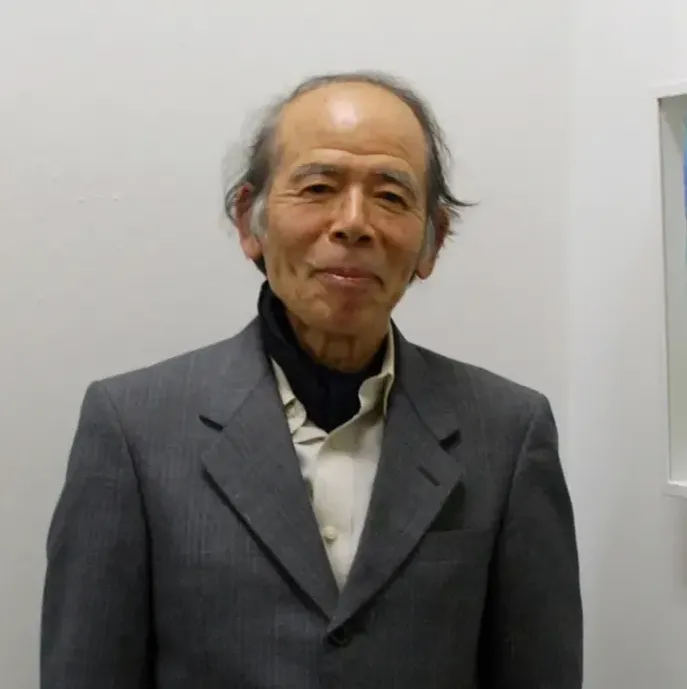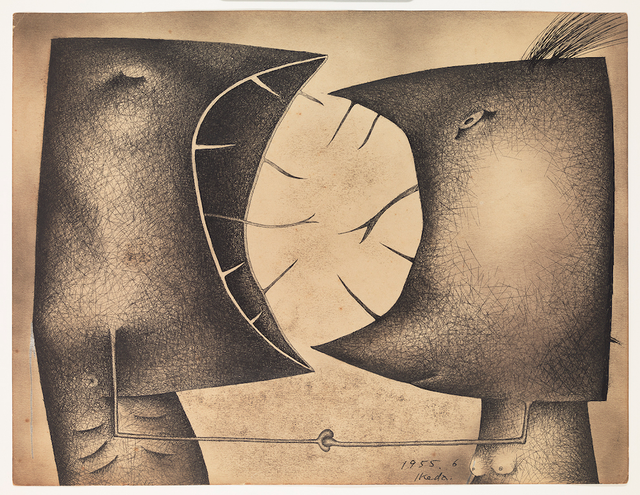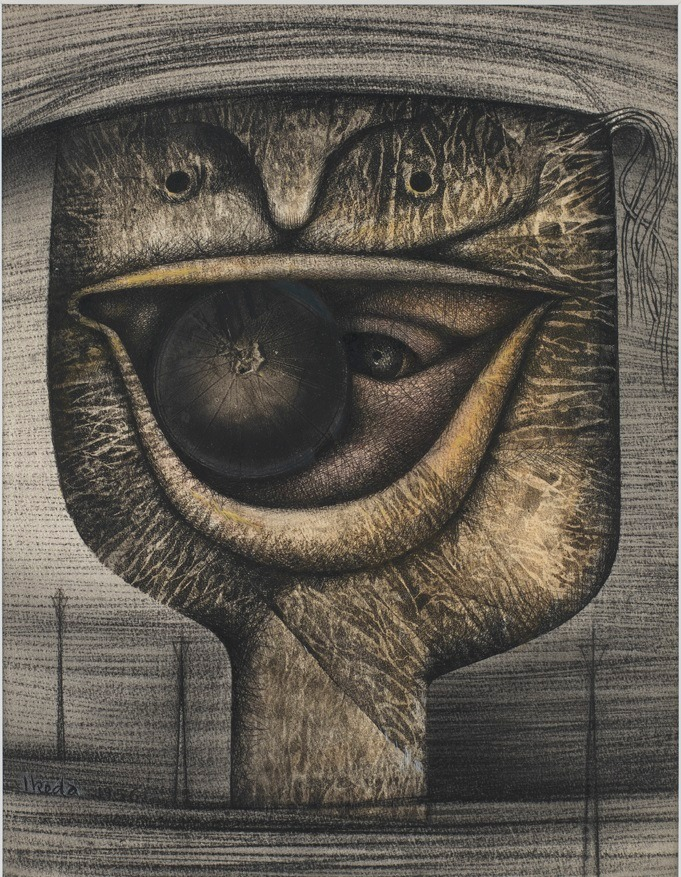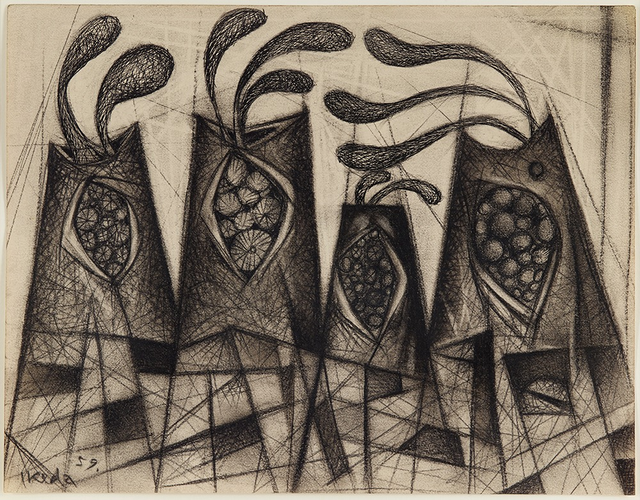
Tatsuo Ikeda
Tatsuo Ikeda (August 15, 1928 - November 30, 2020) was a renowned avant-garde artist from Japan who played an active role in the Japanese postwar art scene. Employing techniques of distortion, grotesque figures, biomorphic forms, and a satirical undertone, Ikeda offered sharp commentary on various contemporary issues, including labor politics, class conflicts, Japan-United States relations, nuclear disarmament, and the lingering effects of militarism.
During the 1950s and early 1960s, Ikeda emerged as a leading figure in the Reportage movement. Through his expressive style, influenced by surrealist and realist elements, Ikeda captured the realities of postwar social unrest, providing a powerful visual narrative of the times.
Biography and artworks of Tatsuo Ikeda
Tatsuo Ikeda was born in Imari, Saga Prefecture, in 1928. Growing up during the 1930s and early 1940s, he witnessed the rise of imperial aggression and militarist ideology, which greatly influenced his early education. He was deeply affected by the nationalist sentiments that were prevalent during that time.
In 1941, Ikeda enrolled at Imari Commercial High School, where he was placed in a military training course. At the age of 15, in 1943, Ikeda and his classmates were called upon to volunteer for military service. He was drafted into the Imperial Japanese Navy and trained as a kamikaze pilot. However, before he could be deployed on a suicide mission, the war ended, sparing him from a tragic fate.
In late August of 1945, Ikeda arrived in Saga and discovered that his middle school credentials would be recognized, allowing him to enroll in a teaching school. Unfortunately, he was dismissed due to his political views. In 1948 he moved to Tokyo to enter Tama Art and Design School. There, he became involved in Taro Okamoto and Kiyoteru Hanada’s Avant-garde Art Study Group. The group served as a platform for artists and writers to engage in discussions and debates centered around forging new artistic paradigms that broke away from the remnants of the militaristic past. Although these groups were short-lived, they laid vital intellectual groundwork influenced by Marxist and Surrealist ideas.
In 1953, Ikeda was deeply inspired and created his first mature works. This inspiration came to him while participating in a protest in Uchinada, a seaside village where he saw the U.S. military using the beaches as a firing range for artillery. Using the cheapest materials available to him, like ink and paper, Ikeda created a series of highly expressive drawings that seamlessly combined elements of reportage and satire.
The detonation of U.S. thermonuclear bomb tests in the Pacific (1954) ignited a deep sense of outrage within Ikeda, compelling him to transform his artistic representations of human and animal life. This shift in his artistic approach was not only a response to the devastating consequences of these tests but also a reflection of the adverse effects of Japan's rapid reindustrialization during that period. Guided by this spirit, Ikeda embarked on several monumental series of artworks between 1955 and 1960. These included the Genealogy of Monsters, An Album of Birds and Beasts, and One Hundred Masks. Each series delved deep into the profound symbolism of the era, offering a contemplative exploration of the monstrous consequences unleashed upon the world. Through these works, Ikeda explored the complexities of humanity's relationship with nature, technology, and the impact of nuclear weapons.
The signing of the Treaty of Mutual Cooperation and Security between the United States and Japan in 1960, despite widespread protests, had a profound impact on Ikeda's artistic direction. During this time, he shifted his attention from social issues to exploring the complex structures of the human body and the depths of human consciousness on a molecular level. This exploration culminated in his Elliptical Space series, created between 1963 and 1964.
Following the Elliptical Space series, Ikeda embarked on his Toy World series (1966-1970). This series showcased a remarkable fusion of Ikeda's ongoing social concerns with influences from Surrealist artist Hans Bellmer, elements of Japanese pop culture, and psychedelia.
After years of studying, Ikeda began creating the Brahman series in 1973. This series held a special significance for him, as he believed it would become the central focus of his creative endeavors for the remaining years of his life. Drawing inspiration from Hindu philosophy, Ikeda delved into exploring the metaphysical connections that lie at the core and unite the vast diversity found within the universe. Through hundreds of meticulously crafted chalk and ink drawings, Ikeda captured the essence of these metaphysical bonds.
Ikeda completed his Brahman series in 1988 and shifted his focus to creating assemblage paintings and sculptures in his Phases of Fields series. Alongside his visual art, Ikeda was also a highly acclaimed writer. Notably, Ikeda's works have been featured in exhibitions worldwide.
Ikeda's life came to an end in 2020 at the age of 92. His passing left a void in the artistic community, marking the conclusion of a remarkable journey filled with artistic exploration, social commentary, and profound creative contributions.
Tatsuo Ikeda's art style
Ikeda's art style changed over his lifetime, but his pieces always reflected a profound awareness of social and political issues, combined with a tendency to blend surreal and realist elements. His gift for fusing these diverse influences resulted in a distinctive visual language that rendered his art both visually captivating and intellectually stimulating.
The artworks of Tatsuo Ikeda often feature distorted figures, biomorphic shapes, and grotesque elements, all imbued with a touch of satire. Ikeda skillfully integrates various elements to create thought-provoking and unique compositions.
Years:
Born in 1928
Country:
Japan, Imari, Saga Prefecture
Gallery:



